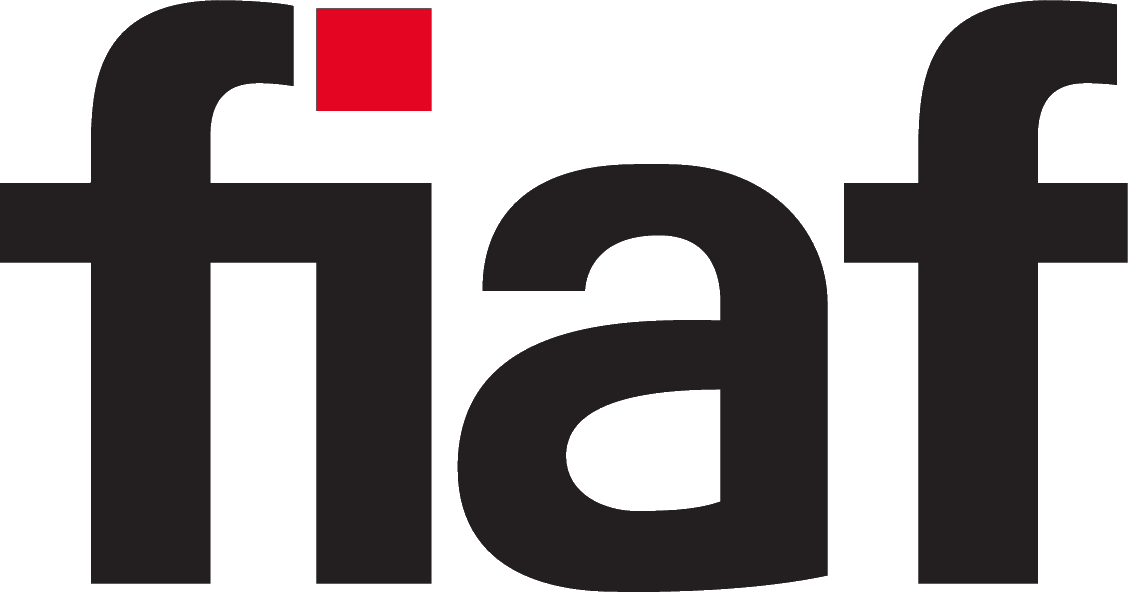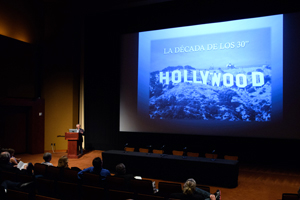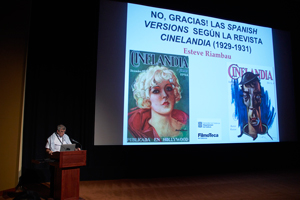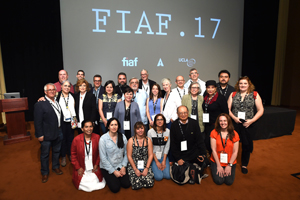2017 FIAF Symposium
“Hollywood Goes Latin: Spanish-Language Cinema in Los Angeles”
In conjunction with the 73rd FIAF Congress in Los Angeles, the UCLA Film and Television Archive and the Academy of Motion Picture Arts and Sciences organized a symposium held during the weekend of 29-30 April 2017 on the production of Spanish-language cinema in Los Angeles during the Golden Age of the Hollywood studio system. Funded by the Getty Foundation as a part of their initiative, “Pacific Standard Time: LA/LA,” the symposium was conceived as a prequel to a three-month film program at UCLA in Fall 2017, “Recuerdos de un cine en español: Latin American Cinema in Los Angeles, 1930-1960.” That program will showcase as many as 40 feature films, originally shown in Los Angeles theatres, which document an authentic, indigenous Latino(a) film culture that has been long forgotten by the mainstream.
Few Anglo-Americans in Los Angeles remember that a vibrant Spanish-speaking cinema culture existed in the city from the 1930s through the early 1960s. Spanish-language films were in fact screened in cinemas on downtown’s Main Street at the Teatro Eléctrico, Hildago, California, Mason, Roosevelt, and the Million Dollar (on Broadway), with the great majority of the films coming from Mexico, Argentina, and Cuba, all of which developed indigenous film industries, while Hollywood and independent producers also supplied a significant number of Spanish-language product. Surprisingly, through control of these L.A. theatres, and the existence of over 500 cinemas in the U.S. that occasionally screened Spanish language films, the Mexican film industry was able to set up an almost monopolistic distribution system that operated in direct competition to Hollywood, literally in its own backyard. I can think of no similar oppositional system of film distribution and exhibition operating in the classic studio era. (So-called “Race Film” distribution and exhibition never achieved a similar cohesion, because neither its distributors nor exhibitors were African-American.)
The goal of the symposium, then, was to explore Spanish-language filmmaking by the major studios and independents in the United States. In both cases, producers were seeking to capitalize on the Spanish-language market of the Americas and Spain. In the 1930s, such films were produced in two phases. With the coming of sound, Paramount, 20th Century-Fox, Warner Brothers, Metro-Goldwyn-Mayer, and to a lesser extent, Universal, produced Spanish-language versions of their American productions in Hollywood, or in the case of Paramount, in Astoria and Paris-Joinville. Indeed, more than 78 Spanish language versions of English films were screened in Los Angeles between 1930 and 1932, usually shot on the same sets and in the same costumes, but with Spanish-speaking actors. Numerous Latin American filmmakers learned their craft on these Spanish versions before returning to help build native film industries in Latin America. However, Paramount and Fox also produced another 30 Spanish-language originals for their Latino(a) stars, including Carlos Gardel and José Mojica, while independent producers released at least 15 Spanish-language originals in Hollywood rental studios. In the aftermath of the Mexican cinema’s worldwide success with Allá en el Rancho Grande (1936, dir. Fernando de Fuentes), Latin American producers working in Los Angeles again ramped up production in the years 1936-40, producing at least 18 features locally.
The existing literature on American Spanish-language films has for the most part identified these more than 30 independents as a part of Hollywood’s hegemonic push to dominate Latin America, when in fact these films should be considered a minority cinema. Furthermore, as the Symposium demonstrated, the often-cited denigration of such Spanish Hollywood films by nationalist-oriented intellectuals and film critics in Latin America belies the fact that most of these films were indeed popular with local audiences.
Symposium papers therefore discussed an array of Latin American filmmakers, stars, crafts-people, exhibitors, and distributors involved in the production and circulation of U.S.-made Spanish-language films. The goal was to better understand the different layers of cultural transference and exchange between the Hollywood industry, its Latin American competition, and, most importantly, local audiences. Film scholars and archivists from ten countries, including Argentina, Mexico, Cuba, Puerto Rico, Peru, Columbia, and Chile happily participated on panels, even though they were responsible for making their own travel arrangements. Saturday opened with a panel on L.A.’s Spanish-language producers, including papers by Robert Dixon, a pioneer in this research area; Lisa Jarvinen, author of the most important book on Hollywood’s Spanish-language film production; Marisel Flores-Patton, who talked about the career of Puerto Rican film producer, Rafael Cobain; and Jan-Christopher Horak, who presented research on the Spanish California production company Cantabria Films.
The second and third sessions focused on filmmakers trained in Hollywood who became founders of their national film industries, like Argentineans Luis Saslavsky (Paula Félix-Didier), Carlos Borcosque (María Elena de las Carreras), and Carlos Gardel (Marcela Cassinelli); Mexicans José Mojica (Rosario Vidal Bonifaz), Guillermo Calles (Rogelio Agrasánchez, Jr.), and Gabriel García Moreno (Esperanza Vázquez Bernal); Spaniards Antonio Moreno (Mar Díaz Martínez), Romaldo Tirado (Alejandra Espasande Bouza), and Conchita Montenegro (Núria Bou Sala); and Cuban, Ramón Peón (Luciano Castillo). Other presentations focused on the reception of this hybrid cinema, including papers by Violeta Nuñez Gorritti, Esteve Riambau Möller, and Tzutzumatzin Soto Cortés. The final panel on Sunday, “Preserving and Screening Spanish-language Cinema,” led to an unexpectedly heated discussion about perceived deficits in Latin American archives, especially their lack of coordination among themselves, and included Roberto Quintana Green, Albino Álvarez Gómez, Juana Suárez, and Pamela Vizner Oyarce.
The Symposium concluded with screenings on Sunday night of two locally produced Spanish-language features: ¡Asegure a su mujer! (1935), produced by Fox and preserved by the Academy Film Archive, and Castillos en el aire (1938), a film independently produced by Venezuelan-American bandleader Eddie Le Baron, and newly restored by Filmoteca de la UNAM and the UCLA Film & Television Archive. Both films were well received, as was the Symposium, which even non-specialists agreed brought to light many new and interesting aspects of Latin American film history.
Jan-Christopher Horak
UCLA Film and Television Archive
This text was first published in the FIAF Bulletin Online, #13, June 2017








